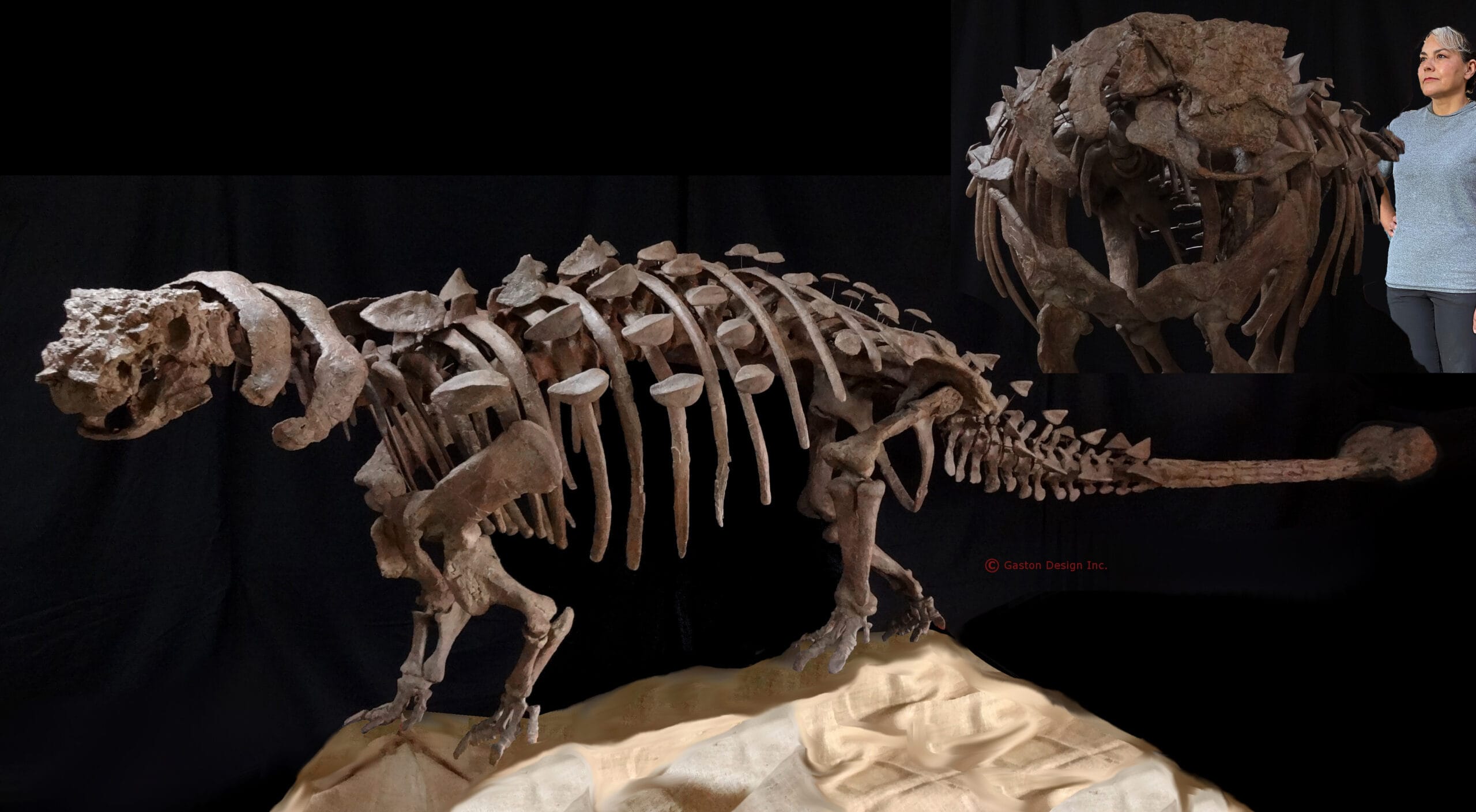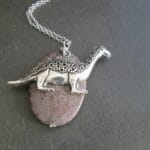Journey to the Late Cretaceous: Unveiling the Ankylosaurus
Let’s travel back to the Late Cretaceous period, when dinosaurs ruled the Earth. Our destination: the world of the Ankylosaurus, a dinosaur so heavily armored it puts modern tanks to shame. These gentle giants, content to munch on plants, left behind a legacy in the form of fossilized bones, offering us a glimpse into their incredible world.
Unearthing the Past: The Ankylosaurus Fossil Record
The first Ankylosaurus fossil was unearthed in 1906 by the renowned fossil hunter Barnum Brown. This discovery was like finding the first page of a lost dinosaur diary! Since then, more Ankylosaurus fossils have been found across North America, each one adding a new piece to the puzzle of their existence.
A Walking Fortress: Deconstructing the Ankylosaurus’s Defenses
Imagine a dinosaur covered from head to tail in thick, bony plates called osteoderms – that’s our Ankylosaurus! These plates acted like a suit of armor, probably making it nearly impossible for predators to land a bite. And if that wasn’t enough, they also had a massive club at the end of their tail! This was likely their go-to defense move, sending even the bravest carnivores running for the hills.
Let’s not forget their heads: wide, low to the ground, with a mouthful of small, leaf-shaped teeth, perfect for chomping on low-lying ferns and plants. They were like the prehistoric version of a living lawnmower!
A Day in the Life of Ankylosaurus
Now, picture the Late Cretaceous period. Alongside our heavily armored herbivore roamed some of the most iconic dinosaurs, like the mighty Tyrannosaurus Rex and the three-horned Triceratops. Ankylosaurus probably preferred a peaceful life, either roaming alone or in small groups, peacefully grazing in a variety of environments, from lush coastal plains to dense forests.
Unveiling the Mysteries: Ongoing Ankylosaurus Research
The study of Ankylosaurus fossils is an ongoing adventure! Each new discovery brings us closer to understanding these fascinating creatures. Today, scientists are using cutting-edge technology like 3D scanning to create incredibly detailed models of Ankylosaurus bones. We’re still trying to figure out how they moved with all that armor, how they interacted with each other, and just how powerful that tail club really was!
Ankylosaurus: A Window to the Past
Ankylosaurus fossils aren’t just old bones; they’re time capsules, giving us a glimpse into a world millions of years in the making. By studying them, we learn not only about the Ankylosaurus itself, but also about the amazing diversity of life in the Late Cretaceous and how life on Earth has evolved over time. There are still so many questions to answer, and that’s what makes studying dinosaurs so exciting! Every fossil holds a new clue, and who knows what amazing discoveries await us in the future?
Where Were Ankylosaurus Fossils Found?
We’ve talked about how cool Ankylosaurus was, but how do we even know they existed? It all comes down to fossils! We’ve actually found quite a bit of evidence that suggests these armored giants roamed the earth millions of years ago.
The first Ankylosaurus fossils were discovered in 1906 by a famous paleontologist named Barnum Brown. He was digging in the Hell Creek Formation in Montana, a place known for its dinosaur discoveries. Since then, more Ankylosaurus bones have been found in other parts of western North America, like Wyoming and even Canada!
These fossils are like puzzle pieces that help us figure out what Ankylosaurus looked like. We’ve found their iconic bony plates, which acted like a suit of armor, and their powerful tail clubs, which were probably used for defense against predators such as the Allosaurus. It’s amazing to imagine these creatures lumbering around, munching on plants, and using their built-in defenses to survive in a world full of challenges.
However, there’s still a lot we don’t know. For example, we’ve never found a complete Ankylosaurus skeleton! This makes it tricky to get a full picture of their anatomy and how all the pieces fit together. Did they have any other unique features that haven’t been preserved in the fossil record? It’s a question that keeps paleontologists searching!
Another mystery is their social behavior. Did Ankylosaurus hang out in groups like some other herbivores, or were they loners? There’s not much evidence to go on, so it’s fun to imagine the possibilities. Maybe they traveled in herds for protection, or perhaps males battled each other for dominance using their tail clubs – it’s a prehistoric mystery waiting to be solved!
Every new fossil discovery brings us closer to understanding these fascinating creatures and their place in the Late Cretaceous ecosystem. Ankylosaurus continues to capture our imaginations, reminding us of the incredible diversity of life that once existed on Earth and the many secrets still waiting to be unearthed.
How Old is the Ankylosaurus Fossil?
Picking up where we left off, let’s talk about how long ago Ankylosaurus actually walked the Earth. Ankylosaurus lived during the reign of the dinosaurs, which was nearing its end, about 68 to 66 million years ago. This period, known as the Late Cretaceous, was a time of significant change. It’s during this time that our armored friend, Ankylosaurus, roamed what is now North America.
The first hints of this incredible dinosaur emerged in 1906, from the depths of Montana’s Hell Creek Formation. Since then, Ankylosaurus fossils have also appeared in the fossil record of the Anomalocaris. Despite over a century of digging and research, Ankylosaurus fossils are still quite rare. This makes each discovery like a puzzle piece, slowly revealing more about how these fascinating creatures lived, and ultimately, what led to their extinction. Many mysteries remain, reminding us that the world of dinosaurs still holds secrets waiting to be unearthed.
What is the New Ankylosaurus Fossil?
A fascinating discovery was made in the Middle Atlas Mountains of Morocco – a brand new ankylosaur dubbed Spicomellus afer. What makes this dinosaur so special? Well, it’s the first of its kind ever found in Africa! And it gets even cooler: this dino was rocking a seriously unique look with a “collar of spikes” unlike any other known ankylosaur.
Now, you might be thinking, “Okay, cool spikes, but what’s the big deal?” This discovery challenges what we thought we knew about where ankylosaurs lived. Before Spicomellus afer came along, these armored dinosaurs were believed to have mainly lived in the Northern Hemisphere. This new find suggests that these dinos were more widespread than previously thought, and maybe even more diverse in their adaptations.
So, what does this all mean? Scientists are still piecing together the puzzle of Spicomellus afer and its place in the grand scheme of ankylosaur evolution. This discovery opens up a whole new world of possibilities, hinting at a potentially thriving dinosaur community in Cretaceous Africa that we’re only just beginning to uncover. One thing is for sure: Spicomellus afer is a game-changer, and we can’t wait to see what other secrets these ancient armored giants have left behind for us to discover!
- Unlock Water’s Symbolism: A Cross-Cultural Exploration - April 20, 2025
- Identify Black and White Snakes: Venomous or Harmless? - April 20, 2025
- Unlocking Potential: Origins High School’s NYC Story - April 20, 2025
















1 thought on “Unveiling the Secrets of the Ankylosaurus Fossil: An Armored Giant’s Legacy”
Comments are closed.